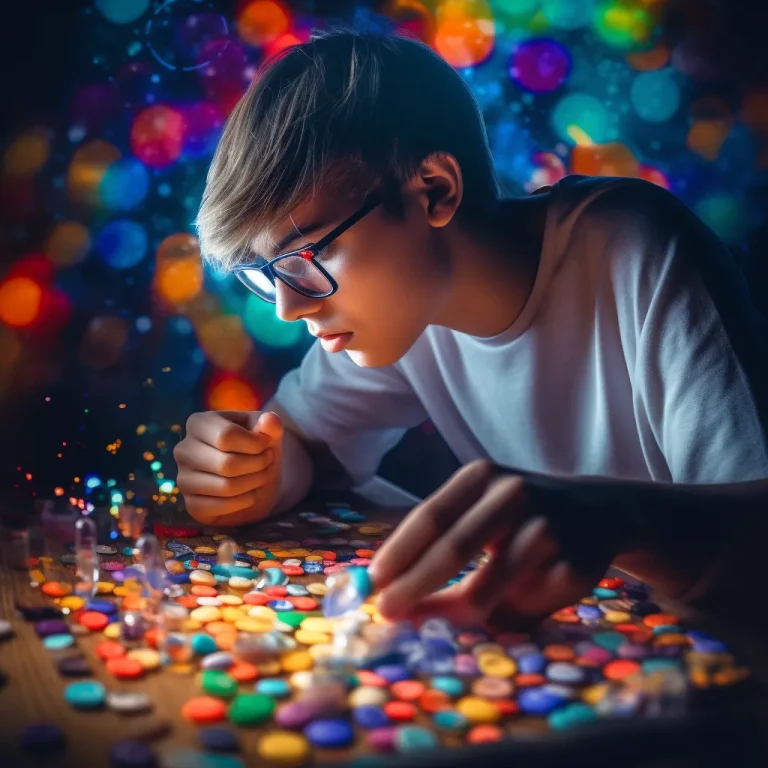Introduction
LSD’s influence on visual art has been profound, shaping artistic movements and pushing the boundaries of creative expression. LSD, a potent hallucinogenic substance, alters perception and induces vivid visual experiences. The connection between LSD and visual art is integral to understanding the transformative impact of psychedelics on artistic expression. This article explores this influence, tracing LSD’s impact from the psychedelic art movement to visionary art. By examining the artistic techniques and themes connected to LSD, we can gain a deeper appreciation for the vibrant world of LSD-influenced art.
Psychedelic Art: The Birth of a Movement
The psychedelic art movement emerged in the 1960s, coinciding with widespread LSD and psychedelic use. Artists aimed to capture the hallucinatory experiences and expanded consciousness induced by these substances. Psychedelic art is characterized by vibrant colors, intricate patterns, and distorted forms that reflect the visual distortions experienced during an LSD trip. Artists like Alex Grey, Mati Klarwein, and Robert Venosa embraced psychedelic aesthetics, pushing traditional art forms’ boundaries. Their works, reminiscent of hallucinations and mystical experiences, continue to captivate and inspire audiences.
Perception and Synesthesia: Visualizing Altered States
LSD’s influence on visual art extends beyond representation, delving into perception and synesthesia. LSD alters perception, heightening sensory experiences and blurring boundaries between senses. Artists have strived to translate these altered states of consciousness into visual representations, capturing synesthetic experiences where sound, color, and form intertwine. Artists like Wassily Kandinsky and Morris Graves embraced synesthetic experiences, translating them into abstract and expressive works. Research suggests that psychedelics like LSD can induce synesthesia-like experiences by enhancing cross-modal associations in the brain (Luke & Terhune, 2013). This connection between LSD, synesthesia, and visual art underscores the intricate relationship between altered perception and artistic expression.
Surrealism and Non-Representational Art
LSD’s influence extends to surrealism and non-representational art, challenging traditional reality notions and representation. Surrealist artists sought to explore the subconscious mind, tapping into the dream-like qualities induced by LSD. Salvador Dalí, known for his surrealistic works, drew inspiration from his LSD experiences, creating visually captivating and thought-provoking pieces. LSD’s ability to dissolve boundaries and distort reality also influenced non-representational art. Artists like Mark Rothko and Jackson Pollock, associated with abstract expressionism, embraced LSD’s free-flowing nature, creating art that emphasizes emotion, gesture, and spontaneity.
Visionary Art: Spiritual and Transcendent Themes
LSD played a significant role in the birth of the visionary art movement, deeply rooted in spiritual and transcendent experiences. Visionary artists seek to depict mystical realms, transcendence, and the interconnectedness of all things. Artists like Alex Grey, Android Jones, and Amanda Sage explore spirituality, consciousness expansion, and the mystical dimensions of existence themes. Their art often embodies a sense of awe and wonder, evoking profound spiritual experiences similar to those encountered during LSD trips. The spiritual and transcendental themes in visionary art reflect LSD’s profound impact on the artists’ perception of reality and their exploration of human consciousness depths.
Psychedelic Colors and Patterns: Exploring Aesthetics
One of the most striking visual aspects of LSD-influenced art is the vibrant colors and intricate patterns that often adorn the canvas. LSD experiences are known for their intensified color perception, resulting in artworks pulsating with energy and vibrancy. Artists like Bridget Riley and Victor Vasarely embraced geometric patterns and Op Art, influenced by
the visual distortions experienced during an LSD trip. These artists harnessed psychedelic colors and patterns to create visually stimulating and immersive artworks that captivate the viewer.
Cultural and Societal Impact
LSD’s influence on visual art extends beyond the artistic realm, having a profound impact on popular culture and societal norms. The psychedelic art movement challenged conventional artistic norms and pushed boundaries, paving the way for experimentation and freedom of expression. LSD-influenced art became emblematic of the 1960s counterculture movement, reflecting broader social and cultural shifts. The bold and unconventional imagery associated with LSD-influenced art continues to inspire artists, musicians, and filmmakers, influencing contemporary artistic expressions and cultural movements.
Ethical Considerations and Responsible Use
The exploration of LSD’s influence on visual art raises ethical considerations about using mind-altering substances in creative processes. Artists must navigate boundaries between inspiration, self-expression, and personal well-being. It’s crucial to promote responsible use and create awareness around potential risks and challenges associated with drug use. Artists should be mindful of their mental health, engage in informed decision-making, and foster a supportive and safe environment for their creative endeavors.
Conclusion
The influence of LSD on visual art has been profound and far-reaching. From the psychedelic art movement to visionary art’s emergence, LSD has shaped artistic movements, challenged traditional artistic norms, and inspired a new creativity wave. The unique artistic techniques, themes, and aesthetics associated with LSD’s influence continue to captivate audiences and ignite conversations about the psychedelics-art intersection. By appreciating LSD’s impact on visual art’s rich history and ongoing legacy, we can gain a deeper understanding of the transformative power of artistic expression and altered states of consciousness’s profound influence.
[gap height=”130px”]
[ux_image id=”8401″]
[gap height=”130px”]
We hope that you have gained a little more understanding and wisdom after reading through our article about LSD. We hope that it has inspired you to explore the multitude of possibilities through LSD.
Shroomhub is your trusted online source in Canada for all things Psychedelic, from Magic Mushrooms, LSD and even DMT, take advantage of our weekly deals and bargain prices you wont find anywhere else!
[gap height=”130px”]
[message_box]
[row v_align=”middle” h_align=”center”]
[col span=”9″ span__sm=”12″]
Author
Freelance Writer
Leo Thomas
[/col]
[col span=”2″ span__sm=”12″ align=”center”]
[button text=”Linkedin” color=”white” style=”outline” radius=”99″ link=”https://www.linkedin.com/in/leo-thomas-24b827279/”]
[/col]
[/row]
[/message_box]


